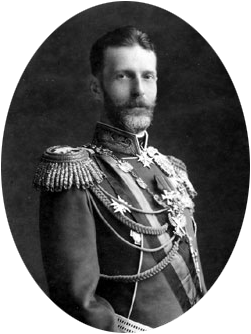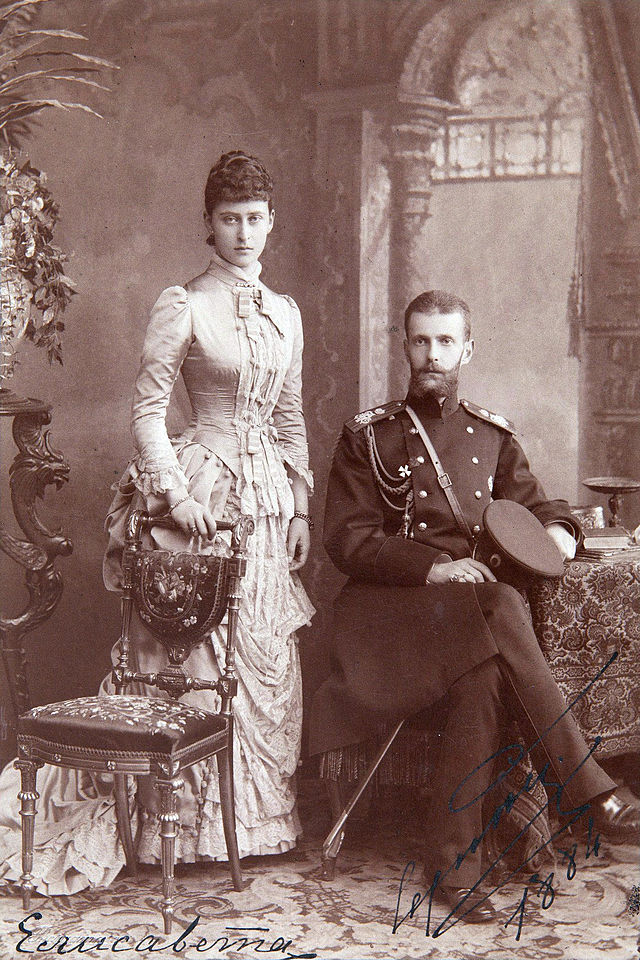by Susan Flantzer © Unofficial Royalty 2015

photo: Wikipedia
Grand Duke Sergei “Serge” Alexandrovich of Russia was the husband of Princess Elisabeth “Ella” of Hesse and by Rhine, a granddaughter of Queen Victoria. He was born on May 11, 1857, at the Catherine Palace at Tsarskoye Selo near St. Petersburg, Russia, the son of Alexander II, Emperor of All Russia and Princess Marie of Hesse and by Rhine.
He had seven siblings:
- Grand Duchess Alexandra Alexandrovna (1842-1849) – died of meningitis shortly before her 7th birthday
- Tsarevich Nicholas Alexandrovich (1843-1865) – engaged to Princess Dagmar of Denmark, died of meningitis
- Alexander III, Emperor of All Russia (1845-1894) – married Princess Dagmar of Denmark, had issue
- Grand Duke Vladimir Alexandrovich (1847-1909) – married Duchess Marie of Mecklenburg-Schwerin, had issue
- Grand Duke Alexei Alexandrovich (1850-1908) – had issue (illegitimate)
- Grand Duchess Marie Alexandrovna (1853-1920) – married Prince Alfred, Duke of Edinburgh and later Duke of Saxe-Coburg and Gotha, had issue
- Grand Duke Paul Alexandrovich (1860-1919) – married (1) Princess Alexandra of Greece, had issue; married (2) Olga Karnovich, had issue

Serge (left) with his mother and brother Paul. Photo: Wikipedia
From an early age, Serge exhibited a passion for languages, music, and the arts, and his early studies focused strongly on these areas. However, he was destined for a career in the Russian military. Following his education, he took the oath of allegiance to the Emperor on his 20th birthday and then served in the Imperial Guard during the Russo-Turkish War of 1877-1878. He continued with his military service and also traveled around the world representing his father. In June 1880, his mother died of tuberculosis while he was on a trip to Italy, and the following March, his father was assassinated. His elder brother, to whom he was very close, became Emperor Alexander III.
In June 1881, Grand Duke Serge, along with his younger brother Paul, traveled to Palestine and Jerusalem, where he established – and served as president of – The Imperial Orthodox Palestine Society, an organization devoted to the preservation and upkeep of the Orthodox shrines, as well as providing services to the Russian pilgrims who visited the lands. This is one of the projects which gave him the most pleasure and satisfaction, and one which he held very dearly for the remainder of his life. The following year, his brother appointed him to the Preobrazhensky Life Guard Regiment, the most senior military group in the Russian forces. Serge eventually reached the rank of Colonel and served as commander of the regiment until 1891.

photo: Wikipedia
Serge was enamored with his first cousin once removed, Princess Elisabeth “Ella” of Hesse and by Rhine. Ella was the daughter of Grand Duke Ludwig IV of Hesse and by Rhine, and Princess Alice of the United Kingdom, the second daughter of Queen Victoria. They were both descended from Grand Duke Ludwig II of Hesse and by Rhine, and often saw each other at family gatherings. Queen Victoria was strongly against the idea of marriage, primarily due to her strong distaste for all things Russian. Despite the misgivings of the two families, Serge was intent on making Elisabeth his bride. In 1883, during a visit to Wolfsgarten, Serge proposed and Ella accepted. The engagement was announced publicly the following February when Serge was again visiting Darmstadt.
The couple married on June 15, 1884, at the Grand Church of the Winter Palace in St. Petersburg, Russia. As Ella had not yet converted to Orthodoxy, there were two ceremonies – one Lutheran and one Russian Orthodox. The wedding was attended by many royals from around Europe, with the noticeable exception of Queen Victoria. Instead, she was represented by two of her sons, The Prince of Wales, and Prince Alfred, Duke of Edinburgh (Serge’s brother-in-law). Following the wedding, they spent their honeymoon at Ilinskoye, Serge’s country estate outside of Moscow, and then settled at the Sergeivsky Palace in St. Petersburg. In addition to these two homes, they also had a home on the grounds of Peterhof, and a house on the bank of the Moskva River. Serge and Ella did not have any children of their own. However, they later took in the children of Serge’s brother Paul – Grand Duchess Maria Pavlovna (the younger), and Grand Duke Dmitri Pavlovich. The children’s mother had died in 1891, and they spent much time with Serge and Ella. In 1902, when Paul entered into a morganatic marriage and was banished from Russia, he was not permitted to take the children, and they were formally put under the guardianship of Serge and Ella.
The couple was very close with Emperor Alexander III and Empress Maria Feodorovna and were often asked to represent them at royal events elsewhere in the world. In 1887, they represented the Emperor at Queen Victoria’s Golden Jubilee, and the following year attended the consecration of the church of Saint Mary Magdalene in Jerusalem, which was built in memory of their mother, the late Empress Maria Alexandrovna.

Serge, 1892. photo: Wikipedia
In 1891, Emperor Alexander III appointed Serge Governor-General of Moscow, and in the following years was also appointed to the Imperial State Council and made Commander of the Moscow military district. As Governor-General, Serge was responsible for major activities and events in Moscow, including the 1896 Coronation of his nephew, Emperor Nicholas II. As part of the events surrounding the coronation, a large event was held at the Khodynka Field just outside of Moscow. Unprepared for such a large number of people and with minimal police presence, over 1,300 people were killed when the crowds surged forward hoping to come closer to the activities. Serge, as Governor-General, bore the ultimate responsibility for the tragedy but refused to accept blame instead of passing it on to others.
Over the next 13 years, Serge would eventually become disenchanted with the policies and decisions of his nephew. Finally, after massive losses in the Russo-Japanese War, Serge resigned his position as Governor-General on January 1, 1905.
Having been targeted by assassins (as were most of the Imperial family), Serge moved his family to the Nicholas Palace within the walls of the Kremlin. Often more concerned with others’ safety than his own, he began to travel without any of his aides, particularly those with families. It was on one of these outings, with just his carriage driver, that his life would come to a tragic end.

the remains of the carriage in which Serge was killed. photo: Wikipedia
On February 17, 1905, Grand Duke Serge left the Nicholas Palace in his carriage, en route to the Governor General’s mansion where he was in the process of clearing out his office. He had just come through one of the gate towers when an assassin threw a nitroglycerin bomb into the carriage from just a few feet away. The bomb landed in Serge’s lap and exploded. The Grand Duke was killed instantly, his body was literally blown to pieces. The assassin, Ivan Kalyayev, who was injured in the attack, was promptly arrested and later executed. Serge’s wife, having heard the blast from the Nicholas Palace, rushed to the scene and began to gather what was left of Serge’s body.
He was buried in a crypt at the Chudov Monastery within the Kremlin in Moscow, Russia. The monastery had been demolished in 1928, and it was not until 1990 that Serge’s grave was discovered. In 1995, his remains were exhumed and reburied in a crypt at the Novospassky Monastery in Moscow, Russia.
This article is the intellectual property of Unofficial Royalty and is NOT TO BE COPIED, EDITED, OR POSTED IN ANY FORM ON ANOTHER WEBSITE under any circumstances. It is permissible to use a link that directs to Unofficial Royalty.
